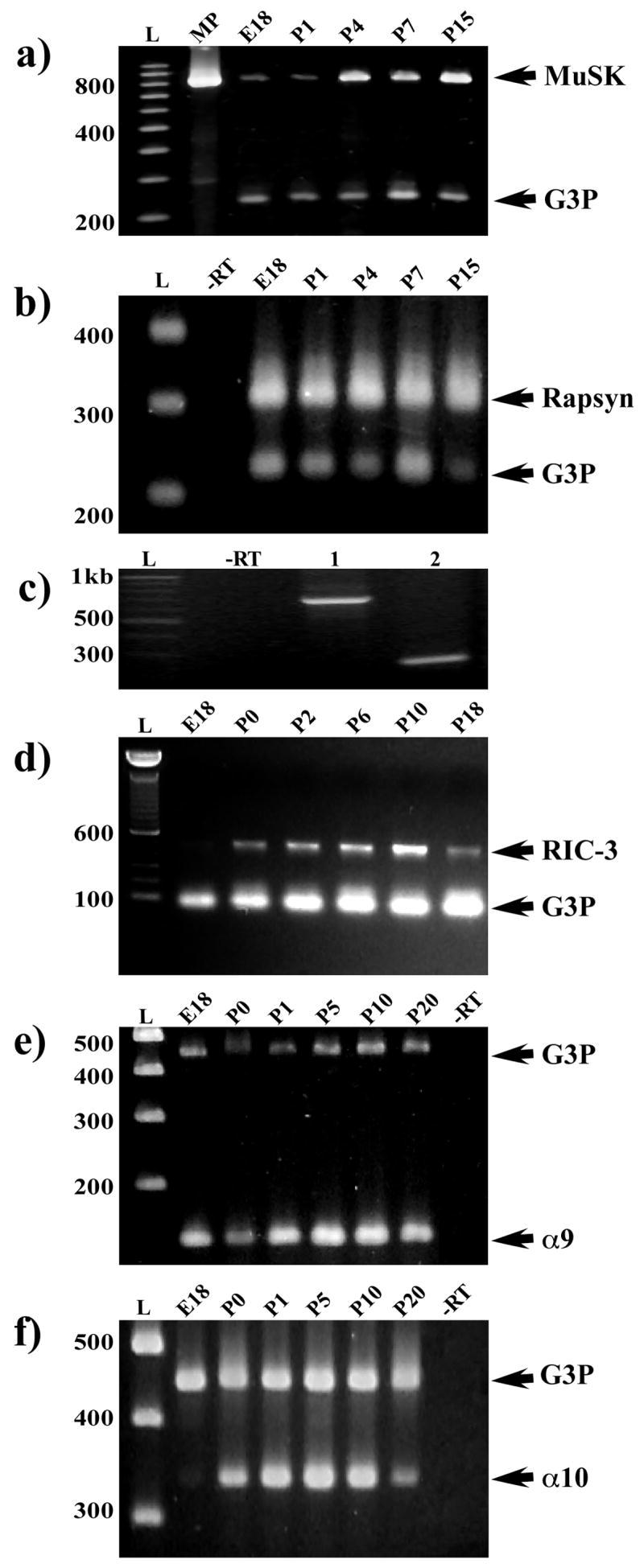Figure 1.

mRNA expression of α9, α10, rapsyn, RIC-3, and MuSK using RT-PCR in developing cochlear tissues. (a) Semi-quantitative analysis of cochlear MuSK expression relative to a gene reporter control (glyceraldehydes-3-phosphate dehydrogenase, G3P). The 829 bp amplicon was generated from gene-specific primers using rat MuSK mRNA sequence (U34895) and contains four of eleven intracellular kinase domains important for MuSK signaling (Fu et al., 1999). The highest levels of MuSK expression occur after P1. MuSK is expressed weakly at E18 and P1. MP = PCR product generated from a cloned insert of an 829 bp amplicon. (b) Semi-quantitative analysis of cochlear rapsyn mRNA expression compared to a gene reporter control (glyceraldehydes-3-phosphate dehydrogenase, G3P). The 303 bp amplicon of rapsyn is expressed at the same relative level throughout the first two weeks of postnatal development. Gene-specific primers were designed using the mouse rapsyn mRNA sequence (NM009023), specifically, a portion containing three of seven potential tetratricopeptide repeats. The RT-PCR includes a –RT control lane. (c) Expression of rapsyn mRNA is seen within isolated OHCs from the apical turn of two-week old rat cochleae. RT-PCR results show a 680 bp and a 222 bp fragment from different regions of the rapsyn rat sequence were amplified from OHC mRNA. (d) A duplex PCR demonstrates that RIC-3 transcripts are developmentally regulated in the mouse ear. A primer pair based on partial rat RIC-3 sequence (GenBankTM accession number XM_219241) was designed to amplify a unique 422 bp PCR fragment contained within the coiled-coil domain. The PCR product detected indicates the presence of RIC-3 transcripts in postnatal mouse cochleae. A 104 bp primer set to glyceraldehyde- 3-phosphate dehydrogenase (G3P, Clontech) was used as a house keeping gene. RIC-3 mRNA was expressed at a relatively low level at E18. The highest levels of RIC-3 expression occurred between P0 and P10 during development. The RT-PCR includes a –RT control lane. (e, f) nAChRα9 and α10 primers were designed against nonoverlapping regions of their cDNA sequences. Primers were designed to amplify a 122-bp fragment of nAChR α9 subunit sequence (GenBank Accession number NM_022930) and a 344-bp fragment of α10 acetylcholine receptor subunit sequence (GenBank Accession number NM_022639). A 450-bp fragment of G3P (Clontech) was used in amplification reactions as an internal control. nAChR α9 was detected in the cochlea at E18 and all subsequent ages. Expression of nAChR α10 mRNA was detected at E21 and all subsequent ages. The RT-PCR includes a –RT control lane.
